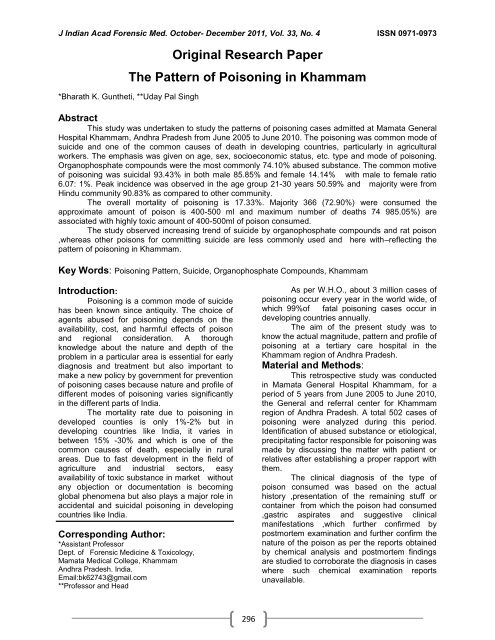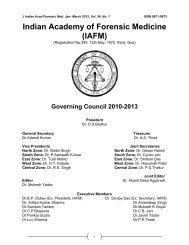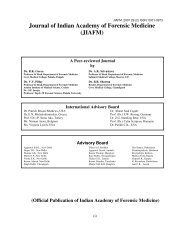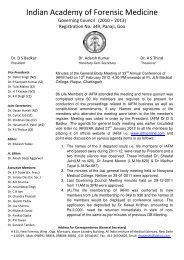Indian Academy of Forensic Medicine (IAFM) - Official website of IAFM
Indian Academy of Forensic Medicine (IAFM) - Official website of IAFM
Indian Academy of Forensic Medicine (IAFM) - Official website of IAFM
You also want an ePaper? Increase the reach of your titles
YUMPU automatically turns print PDFs into web optimized ePapers that Google loves.
J <strong>Indian</strong> Acad <strong>Forensic</strong> Med. October- December 2011, Vol. 33, No. 4 ISSN 0971-0973<br />
Original Research Paper<br />
The Pattern <strong>of</strong> Poisoning in Khammam<br />
*Bharath K. Guntheti, **Uday Pal Singh<br />
Abstract<br />
This study was undertaken to study the patterns <strong>of</strong> poisoning cases admitted at Mamata General<br />
Hospital Khammam, Andhra Pradesh from June 2005 to June 2010. The poisoning was common mode <strong>of</strong><br />
suicide and one <strong>of</strong> the common causes <strong>of</strong> death in developing countries, particularly in agricultural<br />
workers. The emphasis was given on age, sex, socioeconomic status, etc. type and mode <strong>of</strong> poisoning.<br />
Organophosphate compounds were the most commonly 74.10% abused substance. The common motive<br />
<strong>of</strong> poisoning was suicidal 93.43% in both male 85.85% and female 14.14% with male to female ratio<br />
6.07: 1%. Peak incidence was observed in the age group 21-30 years 50.59% and majority were from<br />
Hindu community 90.83% as compared to other community.<br />
The overall mortality <strong>of</strong> poisoning is 17.33%. Majority 366 (72.90%) were consumed the<br />
approximate amount <strong>of</strong> poison is 400-500 ml and maximum number <strong>of</strong> deaths 74 985.05%) are<br />
associated with highly toxic amount <strong>of</strong> 400-500ml <strong>of</strong> poison consumed.<br />
The study observed increasing trend <strong>of</strong> suicide by organophosphate compounds and rat poison<br />
,whereas other poisons for committing suicide are less commonly used and here with–reflecting the<br />
pattern <strong>of</strong> poisoning in Khammam.<br />
Key Words: Poisoning Pattern, Suicide, Organophosphate Compounds, Khammam<br />
Introduction:<br />
Poisoning is a common mode <strong>of</strong> suicide<br />
has been known since antiquity. The choice <strong>of</strong><br />
agents abused for poisoning depends on the<br />
availability, cost, and harmful effects <strong>of</strong> poison<br />
and regional consideration. A thorough<br />
knowledge about the nature and depth <strong>of</strong> the<br />
problem in a particular area is essential for early<br />
diagnosis and treatment but also important to<br />
make a new policy by government for prevention<br />
<strong>of</strong> poisoning cases because nature and pr<strong>of</strong>ile <strong>of</strong><br />
different modes <strong>of</strong> poisoning varies significantly<br />
in the different parts <strong>of</strong> India.<br />
The mortality rate due to poisoning in<br />
developed counties is only 1%-2% but in<br />
developing countries like India, it varies in<br />
between 15% -30% and which is one <strong>of</strong> the<br />
common causes <strong>of</strong> death, especially in rural<br />
areas. Due to fast development in the field <strong>of</strong><br />
agriculture and industrial sectors, easy<br />
availability <strong>of</strong> toxic substance in market without<br />
any objection or documentation is becoming<br />
global phenomena but also plays a major role in<br />
accidental and suicidal poisoning in developing<br />
countries like India.<br />
Corresponding Author:<br />
*Assistant Pr<strong>of</strong>essor<br />
Dept. <strong>of</strong> <strong>Forensic</strong> <strong>Medicine</strong> & Toxicology,<br />
Mamata Medical College, Khammam<br />
Andhra Pradesh. India.<br />
Email:bk62743@gmail.com<br />
**Pr<strong>of</strong>essor and Head<br />
296<br />
As per W.H.O., about 3 million cases <strong>of</strong><br />
poisoning occur every year in the world wide, <strong>of</strong><br />
which 99%<strong>of</strong> fatal poisoning cases occur in<br />
developing countries annually.<br />
The aim <strong>of</strong> the present study was to<br />
know the actual magnitude, pattern and pr<strong>of</strong>ile <strong>of</strong><br />
poisoning at a tertiary care hospital in the<br />
Khammam region <strong>of</strong> Andhra Pradesh.<br />
Material and Methods:<br />
This retrospective study was conducted<br />
in Mamata General Hospital Khammam, for a<br />
period <strong>of</strong> 5 years from June 2005 to June 2010,<br />
the General and referral center for Khammam<br />
region <strong>of</strong> Andhra Pradesh. A total 502 cases <strong>of</strong><br />
poisoning were analyzed during this period.<br />
Identification <strong>of</strong> abused substance or etiological,<br />
precipitating factor responsible for poisoning was<br />
made by discussing the matter with patient or<br />
relatives after establishing a proper rapport with<br />
them.<br />
The clinical diagnosis <strong>of</strong> the type <strong>of</strong><br />
poison consumed was based on the actual<br />
history ,presentation <strong>of</strong> the remaining stuff or<br />
container from which the poison had consumed<br />
,gastric aspirates and suggestive clinical<br />
manifestations ,which further confirmed by<br />
postmortem examination and further confirm the<br />
nature <strong>of</strong> the poison as per the reports obtained<br />
by chemical analysis and postmortem findings<br />
are studied to corroborate the diagnosis in cases<br />
where such chemical examination reports<br />
unavailable.









